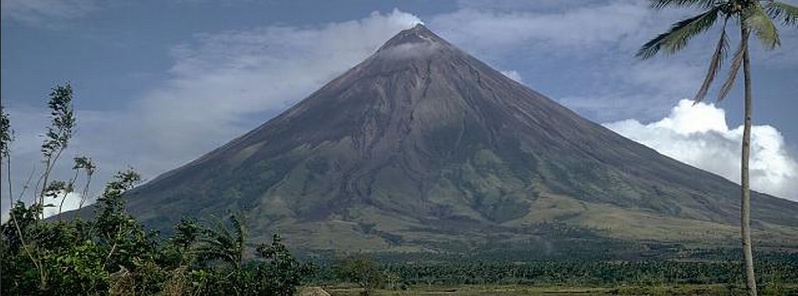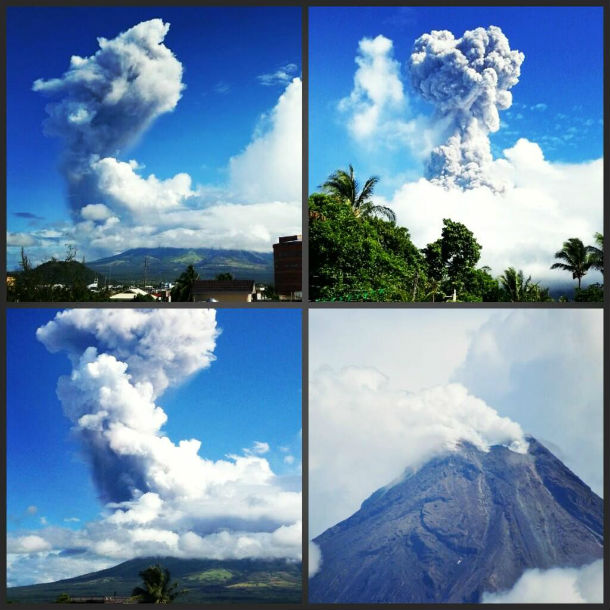Mayon volcano, Philippines: eruption warning issued

After a series of small earthquakes and rockfalls observed on September 15 at the Mayon volcano scientists warned a new eruption could happen within few weeks. Magma is now observable in the crater and authorities said evacuations will be ordered.
According to PHIVOLCS report issued on September 15, 2014, the alert level has been raised from 2 to 3 (out of 5).
This means that Mayon is exhibiting relatively high unrest, magma is at the crater and that hazardous eruption is possible within weeks.
"In the past several hours, a noticeable escalation of unrest was recorded by the Mayon Volcano monitoring network. Since 5:00 AM to 8:00 PM [local time on September 15], 39 rockfall events that are ascribed to incipient breaching of the growing summit lava dome across the southeastern crater rim, and 32 low frequency volcanic earthquakes that indicate magma intrusion and/or volcanic gas activity, have been detected. Crater glow has become observable, indicating incandescence of the crater from molten lava and hot volcanic gas.
It is therefore recommended that the 6-km radius Permanent Danger Zone (PDZ) around the volcano and the 7-km Extended Danger Zone (EDZ) on the southeastern flank be enforced due to the danger of rockfalls, landslides and sudden explosions or dome collapse that may generate hazardous volcanic flows."
During August 27 – September 2 PHIVOLCS reported no incandescence from Mayon, despite the emergence of a summit dome, slight ground deformation, and increased volcanic gas emission. Precise leveling surveys measured the third week of August showed inflationary changes in the edifice since a survey in February 2014. On most days seismic instruments recorded several rock falls and a few earthquakes. Observers noted moderate emission of white steam plumes that drifted SW, WSW, NE, SSW, NNW, WNW, and NW.
Last eruption of Mayon occurred early on May 7, 2013, and lasted for 2 minutes and 26 seconds (VEI 2).
The volcano has erupted more than 40 times since records began. Its most violent eruption was in 1814.

Mayon volcano phreatic explosions on May 7, 2013 (Credit: @tinabogs/noypistuff)
Update
PHIVOLCS – MAYON VOLCANO BULLETIN – September 17, 2014 – 00:00 UTC (08:00 local time)
Mayon Volcano’s (13.2500°N, 123.6833°E) seismic network recorded forty five (38) volcanic earthquakes and two hundred seventy (277) rock fall events during the past 24-hour observation period. Intensity III (bright) crater glow was visible last night, although rain clouds prevented visual observation of the crater during the day. Rolling incandescent rockfall within the uppermost reaches of the Bonga Gully last night indicates that the summit lava dome is breaching the crater in its southeastern side. Sulfur dioxide (SO2) flux was measured at an average of 457 tonnes/day on 12 September 2014 although SO2 emission rates peaked at 2,360 tonnes/day on 06 September 2014. Ground deformation data showed inflationary changes in the edifice from February 2014 based on precise leveling surveys on the 3rd week of August 2014, and edifice inflation from January 2012 baselines based on continuous tilt measurement. All the above data indicate that the volcano is exhibiting relatively high unrest due to the movement of potentially eruptible magma.
Mayon Volcano’s alert status has been raised to Alert Level 3. This means that magma is at the crater and that hazardous eruption is possible within weeks. It is recommended that the 6-km radius Permanent Danger Zone (PDZ) around the volcano and the 7-km Extended Danger Zone (EDZ) on the southeastern flank be enforced due to the danger of rock falls, landslides and sudden explosions or dome collapse that may generate hazardous volcanic flows. PHIVOLCS maintains close monitoring of Mayon Volcano and any new development will be communicated to all concerned stakeholders.
Geologic summary
Beautifully symmetrical Mayon volcano, which rises to 2 462 m above the Albay Gulf, is the Philippines' most active volcano. The structurally simple volcano has steep upper slopes averaging 35-40 degrees that are capped by a small summit crater.
Historical eruptions at this basaltic-andesitic volcano date back to 1616 and range from strombolian to basaltic plinian, with cyclical activity beginning with basaltic eruptions, followed by longer term andesitic lava flows.
Eruptions occur predominately from the central conduit and have also produced lava flows that travel far down the flanks. Pyroclastic flows and mudflows have commonly swept down many of the approximately 40 ravines that radiate from the summit and have often devastated populated lowland areas.
Mayon's most violent eruption (VEI 4), in 1814, killed more than 1 200 people and devastated several towns. (GVP)
Featured image credit: GVP

something about this volcano makes me feel uneasy…a harbinger of doom perhaps? I made a little research and fixed a long time the beautiful picture of the Cagsawa ruins with this perfect shape volcano…perfect like a pyramid, if it errupts at night it will make a perfect glowing eye…and all these poor people who run to this church when the erruption occurs were all buried alive…if the sick elite wants a sign to do something; they got it: the rise of a catastrophe, the death of innocents, the death of religion as a deciever,chaos…perhaps I read too much of before it’s news these days:)